Did you know that 95% of your website visitors won’t convert on their first visit to your website? Would you like to know more about the conversion paths they take before buying or subscribing?
Studies show that it can take 3-4 visits before online customers feel comfortable doing business with you.
If you’re analyzing conversion numbers while overlooking the paths your users took to those conversions, you’re missing valuable insight into how visitors convert into leads and customers.
To better understand how users convert, you can look at conversion paths in Google Analytics. In this article, we’ll show you how to set up and analyze conversion paths in Google Analytics.
What Is a Conversion Path?
A conversion path is a description of steps a website visitor takes before completing a conversion activity on your site. In Google Analytics, a conversion path includes detailed information about conversion sources and touchpoints.
You can define anything a user does as a conversion. Some common examples include completing a purchase, subscribing to a mailing list, or downloading a file.
Understanding Conversion Paths in Google Analytics
With Google Analytics, you can track any type of user interaction or event as a conversion on your site.
When Google Analytics records a conversion, it credits it to however the visitor found your site when he or she converted. So, if a person clicked on a Facebook post, landed on your site and converted, their conversion source would be organic social.
Tracking conversions that happen during a single session (like someone’s first visit to your site) is pretty easy. And it’s great if you’re expecting immediate conversions from a marketing campaign, such as a pay-per-click (PPC) campaign.
By comparing how much money you make versus your ad spend, you can measure the return on investment (ROI) of your PPC campaign and figure out whether it’s profitable.
Tracking Users Over Multiple Sessions
That being said, not every marketing campaign is that simple.
For example, to measure the ROI of your content marketing, you’ll want to look at the entire conversion path over multiple sessions.
Imagine that a visitor reads one of your blog posts and bookmarks the page while researching products. After a few days, they return to your site and purchase an item from your store.
In this example, the conversion will likely be credited to the Direct channel, not the organic search that led your buyer to the original blog post. That’s because this person came directly to your site right before completing their purchase.
But the blog post has assisted the conversion, and it took more than a single visit for your visitor to make a purchase. Unless you look at the whole conversion path, you might miss the impact of your blog post on the conversion.
The Conversion Paths reports in Google Analytics can show you how someone found your site, and what path they took to convert.
Before we dive into the specifics of the report, let’s take a look at how you can see conversion information right inside WordPress.
View Conversions in WordPress with MonsterInsights
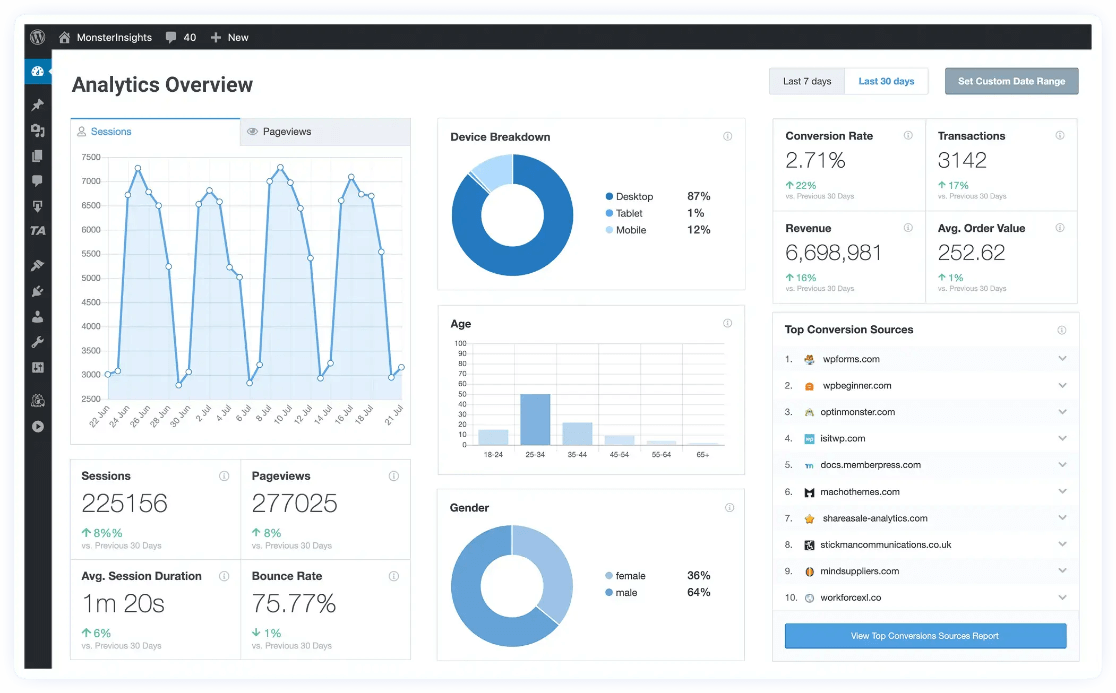
MonsterInsights is the best WordPress plugin for Google Analytics. It makes Google Analytics setup a breeze, and puts all your most important data right in your WordPress dashboard. That includes conversions!
Here are a few examples of conversions you can track with MonsterInsights (without setting up any Google Analytics code):
- Purchases (eCommerce)
- Form submissions
- Outbound link clicks
- Affiliate link clicks
- File downloads
- Video tracking
- Button clicks
Get Started with MonsterInsights Today!
How to View Conversion Paths Reports in Google Analytics 4
According to Google, the conversion paths report helps you understand two things. First, which channels initiate, assist, and close conversions. Second, how different attribution models distribute credit to those conversion paths.
In Google Analytics 4 (GA4), you can view conversion path reports for any event that you’ve defined as a conversion or ‘key event’ as GA4 calls them.
By default, Google tracks the purchase event as a conversion automatically. If you want to track any other events as conversions, you’ll need to set them up as key events in GA4.
To track an existing event as a conversion, log into GA4 and go to the Admin area, then click Events under the Property column.
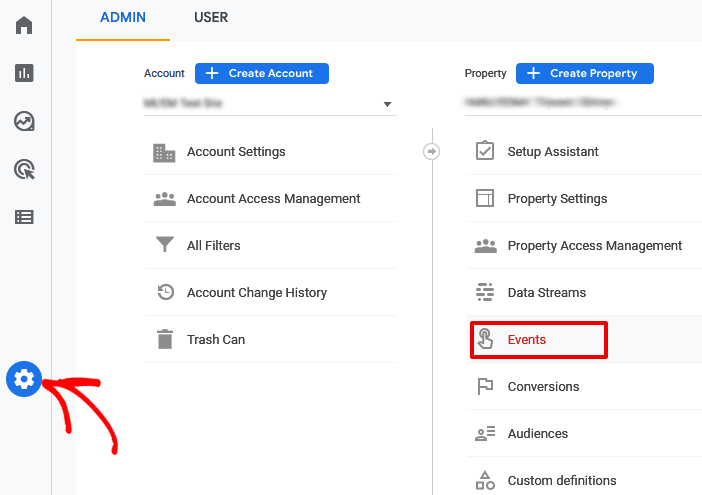
Now, you’ll see a list of events that Google is tracking on your site. To start tracking any event as a conversion, flip the switch in the right column labeled Mark as key event.
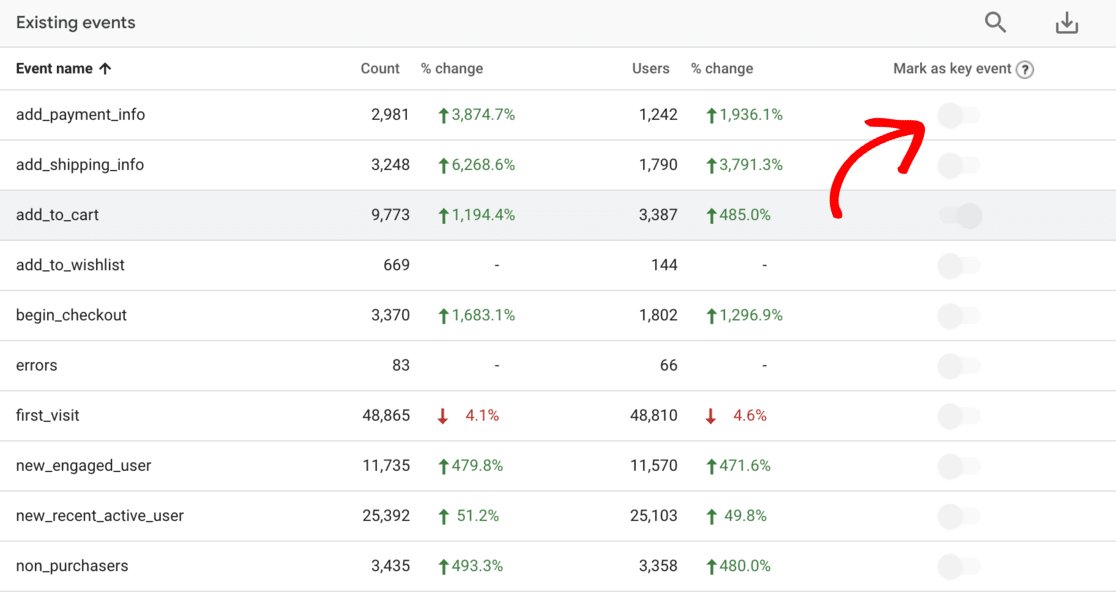
To see which events you have marked as conversions, click on the Key events item in the Property column. You’ll see the conversion events that Google Analytics is currently tracking.

If you need to create a new conversion event, click the New key event button.
Viewing Conversion Paths Reports
Okay, in order to see your conversion paths in GA4, navigate to the Advertising reports menu and click on Conversion paths. You’ll see all of your defined conversion events in the drop-down list to the right.
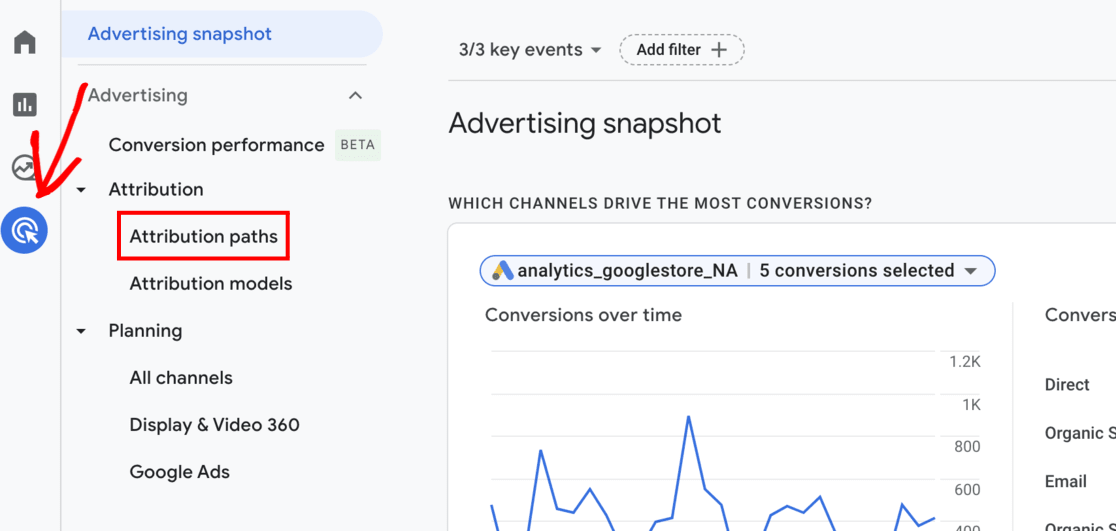
Now, check or uncheck these boxes to view only the conversion paths you want. For example, you could select only the purchase event to see all the conversion paths for users who completed a purchase.
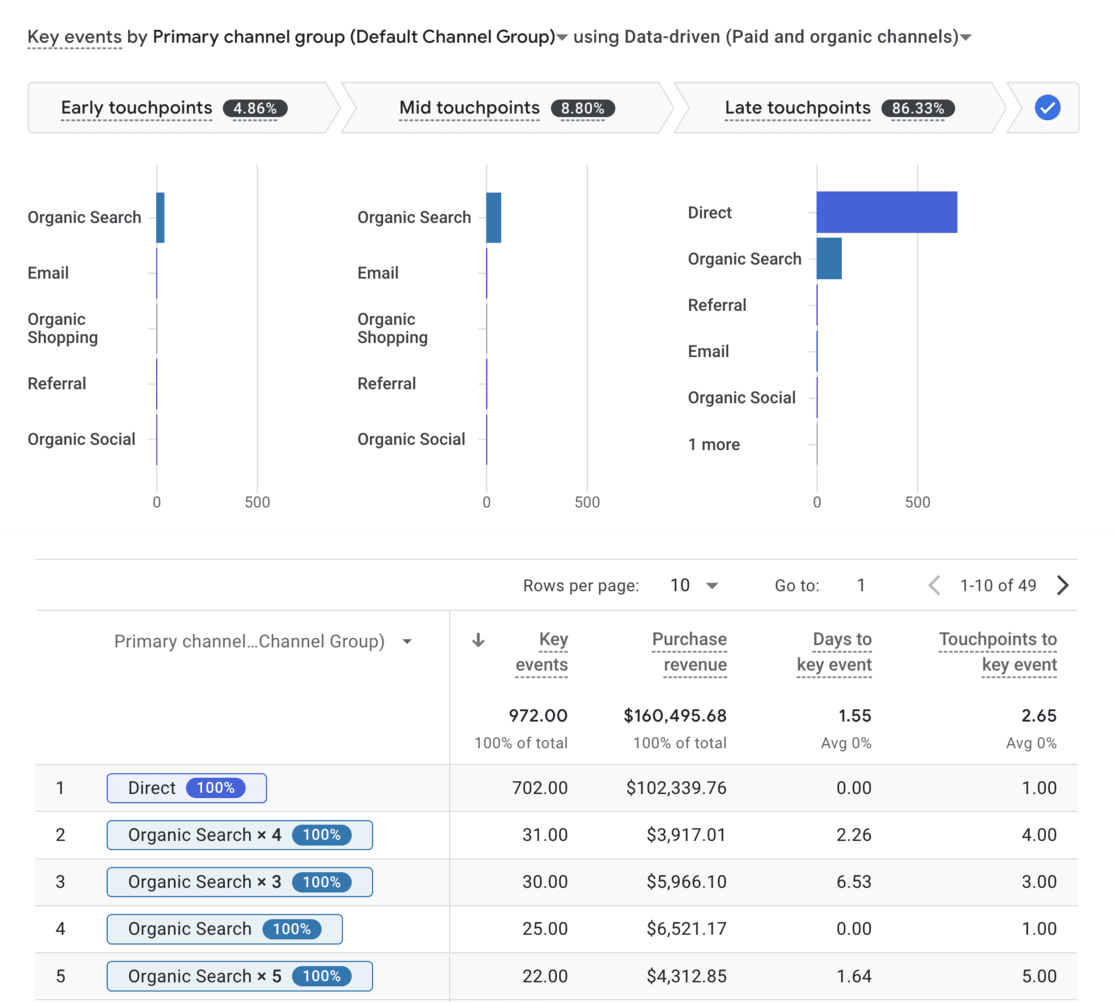
That would show you something like this. The table shows you the paths users take before completing conversions, as well as these metrics:
- Key events
- Purchase revenue
- Days to key events
- Touchpoints to key events
In this example, you can see the most conversions came from direct traffic with a single touchpoint.
The second most came, interestingly, from users who completed 4 organic searches before converting. And those users took an average of over 2 days to convert!
If you need more information, check out this article on customizing and filtering the conversion path report.
Tracking Conversions and eCommerce Metrics in WordPress
If you’re a WordPress and MonsterInsights user, you can get sales metrics right in your analytics dashboard. Look in WordPress under Insights » Reports » eCommerce.
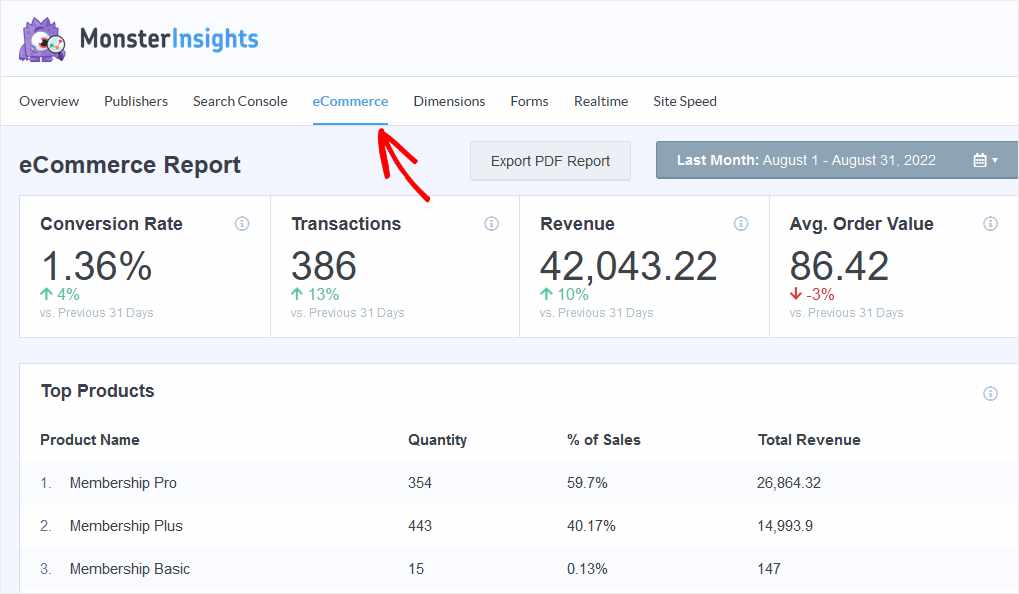
Here, you’ll find these critical eCommerce stats:
- Purchase conversion rate
- Total number of transactions
- Total revenue earned
- Average order value
- Total items added and removed from carts
- Abandoned cart rate
- Percentage of new customers
You’ll also get a list of your top selling products and top conversion sources by revenue.
MonsterInsights supports automated eCommerce setup and reporting for users of WooCommerce, Easy Digital Downloads, MemberPress, LifterLMS, Restrict Content Pro, and GiveWP.
For more on MonsterInsights eCommerce reports, read How to Set Up eCommerce in Google Analytics (Step by Step).
Tracking User Journeys with MonsterInsights
For users of the popular eCommerce plugins mentioned above, MonsterInsights provides even more detailed data on buyer behavior.
The User Journey report in MonsterInsights shows you any UTM data associated with each purchase, the order total, and how many steps it took for the purchase.
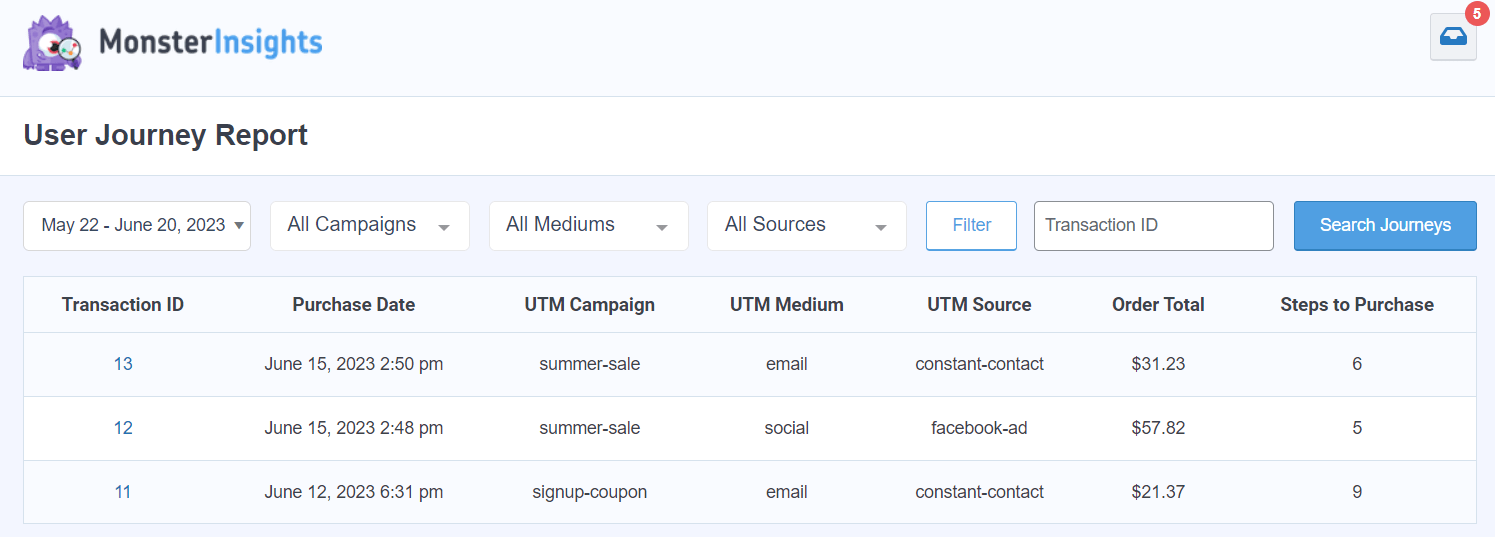
Click on a transaction to see more data about what pages your users visited prior to making an online purchase, when they visited, for how long, and the elapsed time from first visit to conversion.
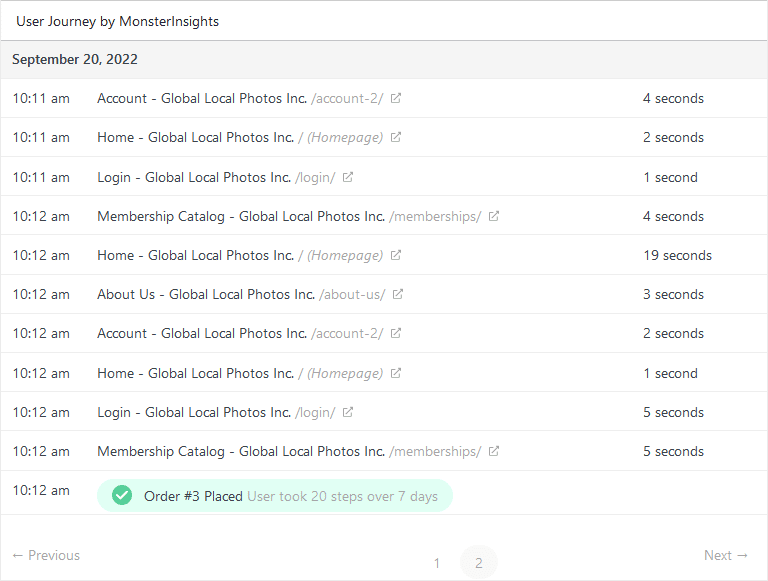
To see more details on setting up your User Journey reports in WordPress, please check out our guide to customer journey analytics.
And that’s it! We hope this guide taught you something new about conversion paths in Google Analytics.
If you want to learn more about your site users’ behavior, read this post on tracking user engagement in WordPress.
Still not using MonsterInsights? What are you waiting for?
And don’t forget to follow us on Twitter, Facebook and YouTube for more helpful Google Analytics tips.
